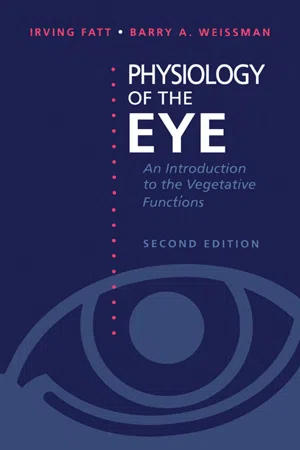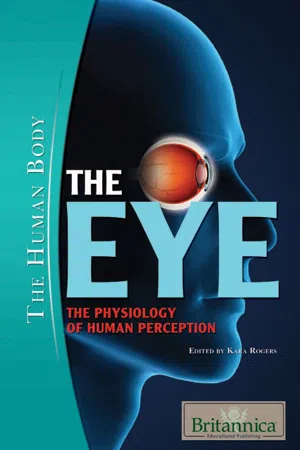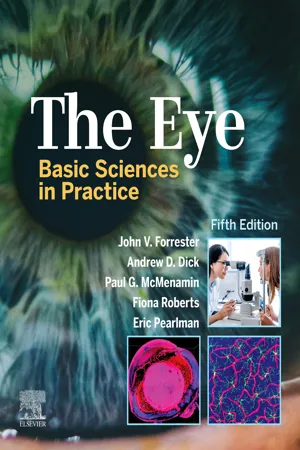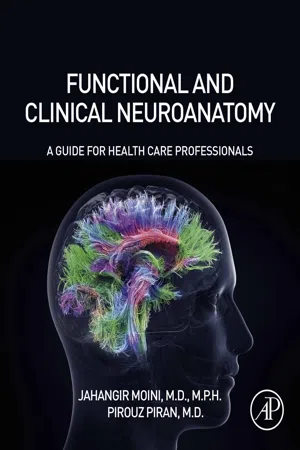Biological Sciences
Eye Anatomy
The eye is a complex organ responsible for vision. Its anatomy includes the cornea, iris, lens, retina, and optic nerve. Light enters through the cornea and is focused by the lens onto the retina, where it is converted into electrical signals that are sent to the brain via the optic nerve, allowing us to perceive the visual world.
Written by Perlego with AI-assistance
Related key terms
Related key terms
1 of 4
Related key terms
1 of 3
10 Key excerpts on "Eye Anatomy"
- eBook - ePub
Physiology of the Eye
An Introduction to the Vegetative Functions
- Irving Fatt, Barry A. Weissman(Authors)
- 2013(Publication Date)
- Butterworth-Heinemann(Publisher)
1Review of Ocular Anatomy
Publisher Summary
This chapter presents a review of ocular anatomy. The eye is an organ in which patterns of light are brought into focus on the retina, and the ensuing chemical reaction leads to an electrical signal propagated in the optic nerve. A cross-section of the eye displays the following elements: the two-lens optical system of cornea and crystalline lens; a variable diaphragm, the iris; a shutter, the lids; a light-tight box, the sciera; and a photosensitive surface, the retina. The extraocular muscles serve to point the eye in the desired direction, within the limits imposed by the bony socket of the orbit. The eye is an organ in which patterns of light are brought into focus on the retina, and the ensuing chemical reaction leads to an electrical signal propagated in the optic nerve. The outer case of the eye is known as the fibrous tunic. It serves—when inflated by the internal fluid pressure—to give shape to the eye and to protect the delicate internal structures.Although there are philosophical objections to a teleological approach to the study of the eye, that is, treating the eye as a device designed to carry out certain desired processes, much of the vegetative physiology of the eye is best grasped through such an approach. Our modern technological society gives us certain intuitive feelings for mechanisms and how they carry out their required functions. If we believe that each part of the eye has its own special function and carries out this function in at least a satisfactory, if not always optimal, fashion, then we must understand the elements and interactions of ocular anatomy for an understanding of ocular function.Many anatomical elements of the eye are best described and understood in connection with their function. For this reason, only gross anatomy is described in this chapter. Most of the detailed anatomy, as necessary, will be described in later chapters when physiological function is discussed. For those who are interested there are several detailed texts concerned solely with ocular anatomy, histology, and physiology. - eBook - ePub
- Lee Ann Remington, Denise Goodwin(Authors)
- 2011(Publication Date)
- Butterworth-Heinemann(Publisher)
Chapter 1 Visual SystemThe visual system takes in information from the environment in the form of light and analyzes and interprets it. This process of sight and visual perception involves a complex system of structures, each of which is designed for a specific purpose. The organization of each structure enables it to perform its intended function.The eye houses the elements that take in light rays and changes them to a neural signal; it is protected by its location within the bone and connective tissue framework of the orbit. The eyelids cover and protect the anterior surface of the eye and contain glands that produce the lubricating tear film. Muscles, attached to the outer coat of the eye, control and direct the globe’s movement, and the muscles of both eyes are coordinated to provide binocular vision. A network of blood vessels supplies nutrients, and a complex system of nerves provides sensory and motor innervation to the eye and surrounding tissues and structures. The neural signal that carries visual information passes through a complex and intricately designed pathway within the central nervous system, enabling an accurate view of the surrounding environment. This information, evaluated by a process called visual perception, influences myriad decisions and activities.This book examines the macroscopic and microscopic anatomy and physiology of the components in this complex system and the structures that support it.The Eye
Anatomic Features
The eye is a special sense organ made up of three coats, or tunics, as follows: 1. The outer fibrous layer of connective tissue forms the cornea and sclera. 2. The middle vascular layer is composed of the iris, ciliary body, and choroid. 3. The inner neural layer is the retina.Within this globe are three spaces: the anterior chamber, posterior chamber, and vitreous chamber. The crystalline lens is located in the region of the posterior chamber (Figure 1-1 - eBook - ePub
- Britannica Educational Publishing, Kara Rogers(Authors)
- 2010(Publication Date)
- Britannica Educational Publishing(Publisher)
CHAPTER 1 ANATOMY OF THE EYEClose-up of a human eye. Shutterstock.comT he human eye is an amazingly complex structure that enables sight, one of the most important of the human senses. Sight underlies our ability to understand the world around us and to navigate within our environment. As we look at the world around us, our eyes are constantly taking in light, a component fundamental to the visual process. The front of the human eye contains a curved lens, through which light reflected from objects in the surrounding environment passes. The light travels deep into the eyeball, passing all the way to the back of the eye, where it converges to a point. A unique set of cells at the back of the eye receives the light, harnessing its energy by converting it into an electrical impulse, or signal, that then travels along neurons in the brain. The impulses are carried along a neuronal pathway that extends from the back of the eye all the way to the back of the brain, ultimately terminating in a region known as the visual cortex. There, the electrical signals from both eyes are processed and unified into a single image. The amount of time between the moment when light enters the eye and when a unified image is generated in the brain is near instantaneous, taking only fractions of a second.Scientists’ knowledge of the intricacy and the complex associations of the vital structures within the human eye expanded tremendously in the 20th and early 21st centuries. Although some of this knowledge was obtained from studies of the eyes of animals, a significant amount of information was also gained from studies of diseases of the human eye. With this knowledge came an understanding of the function of each of the eye structures. Each structure contributes in a specific way to the visual process, and collectively they underlie a broad range of visual functions, from the perception of an object’s shape, size, and colour to the perception of distance. - eBook - ePub
- John V. Forrester, Andrew D. Dick, Paul G McMenamin, Fiona Roberts, Eric Pearlman(Authors)
- 2020(Publication Date)
- Elsevier(Publisher)
Chapter 1: Anatomy of the eye and orbit
- Anatomical terms of reference
- Osteology of the skull and orbits
- General arrangement and features of the skull
- Osteology of the orbit
- Cranial cavity (Fig. 1.8A,B and eFig. 1.1)
- Structure of the eye
- General shape, size and position of the eye
- The cornea
- The sclera
- Limbus and aqueous outflow pathways (Fig. 1.18)
- The iris
- The ciliary body
- The lens and zonular apparatus
- Anterior and posterior chambers
- The vitreous
- Retina and retinal pigment epithelium (Fig. 1.29)
- The choroid
- Optic Nerve
- Orbital contents
- General arrangement
- Periorbita and orbital fibroadipose tissue (Figs 1.43 and 1.44)
- Extraocular muscles
- Blood vessels of the orbit (Fig. 1.50)
- Cranial nerves associated with the eye and orbit
- General functional arrangement
- Oculomotor nerve (cranial nerve III) (Figs 1.52 and 1.53)
- Trochlear nerve (cranial nerve IV)
- Abducent nerve (cranial nerve VI)
- Trigeminal nerve (cranial nerve V) (Figs 1.58 and 1.59)
- Facial nerve (cranial nerve VII) (Figs 1.62 and 1.63)
- Ocular appendages (adnexa)
- Muscles of the eyelids and adjacent face
- The eyelids
- The conjunctiva
- Lacrimal apparatus (Fig. 1.68)
- Anatomy of the visual pathway
- Intracranial portion of the optic nerve (Figs 1.51 and 1.71)
- Optic chiasma
- Optic tracts
- Lateral geniculate bodies
- Optic radiations (geniculocalcarine tracts)
- Primary visual cortex (area 17)
- Secondary visual association areas (areas 18 and 19)
- Frontal eye field
- Retinotopic organization of the visual pathway and visual pathway disturbances (Figs 1.76–1.82)
- Blood supply of the visual pathway
Anatomical terms of reference
The internationally accepted terminology for description of the relations and position of structures in the body requires reference to a series of imaginary planes (Fig. 1.1 ). Thus, relative positions of anatomical structures are referred to in terms of medial (nearer the median or mid-sagittal plane) and lateral (away from this plane); anterior and posterior refer to the front and back surfaces of the body; superior (cranial or rostral) or inferior (caudal) refer to position in the vertical; superficial and deep - eBook - ePub
- James Chambers(Author)
- 2020(Publication Date)
- Omnigraphics(Publisher)
Eye and Eye-Care BasicsChapter 1 | How the Eyes WorkAnatomy of the Eyeball The eye consists of a retinal-lined fibrovascular sphere which contains the aqueous humor, the lens and the vitreous body as illustrated in Figure 1.1.The retina is the essential component of the eye and serves the primary purpose of photoreception. All other structures of the eye are subsidiary and act to focus images on the retina, to regulate the amount of light entering the eye or to provide nutrition, protection or motion. The retina may be considered as an outlying island of the central nervous system (CNS), to which it is connected by a tract of nerve fibers, the optic nerve.As in the case of the brain and the spinal cord, the retina is within two coats of tissue which contribute protection and nourishment. On the outside of the sphere, corresponding to the dura mater, a layer composed of dense fibrous tissue serves as a protective envelope, the fibrous tunic. The posterior part of the fibrous tunic, the sclera, is white and opaque. Although it retains its protective function, the anterior portion, the cornea, is clear and transparent.Immediately internal to the sclera, and between it and the retina, lies the uvea, a vascular tunic analogous to the pia-arachnoid of the central nervous system. Primarily, the uvea provides nutrients to the eye. The posterior portion of the uvea is the choroid, a tissue composed almost entirely of blood vessels. A second portion of the uvea, the ciliary body, lies just anterior to the choroid and posterior to the corneoscleral margin and provides nutrients by forming intraocular fluid, the aqueous humor. In addition, the ciliary body contains muscles which provide a supporting and focusing mechanism for the lens. The most anterior portion of the uveal tract, the iris, is deflected into the interior of the eye. The iris acts as a diaphragm with a central rounded opening, the pupil, which dilates to allow more light to the retina in dim lighting and constricts in bright lighting. The iris also has some degree of nutritive function, since it acts to help regulate the fluid flow in the eye. - eBook - ePub
Functional and Clinical Neuroanatomy
A Guide for Health Care Professionals
- Jahangir Moini, Pirouz Piran(Authors)
- 2020(Publication Date)
- Academic Press(Publisher)
Chapter 14Visual system
Abstract
The sense of sight and our visual system is important for almost everything required for normal living. The eyes allow response to all types of stimuli, as they convert stored photochemical energy into nerve impulses. The visual brain cortex can then interpret these. Our visual system functions by allowing light to enter through the lenses of the eyes, with focusing and inversion of the image onto the retina. Finally, the visual cortex creates the images that we perceive. Recall that visual function is one of the higher cortical functions of the human brain (see Chapter 6 ). Other predominant structures of the eyes include the cornea, sclera, iris, pupil, choroid, and retina.Keywords
Eyeball; Visual acuity; Convergence; Visual pigments; Blindness; Visual cortexThe sense of sight and our visual system is important for almost everything required for normal living. The eyes allow response to all types of stimuli, as they convert stored photochemical energy into nerve impulses. The visual brain cortex can then interpret these. Our visual system functions by allowing light to enter through the lenses of the eyes, with focusing and inversion of the image onto the retina. Finally, the visual cortex creates the images that we perceive. Recall that visual function is one of the higher cortical functions of the human brain (see Chapter 6 ). Other predominant structures of the eyes include the cornea, sclera, iris, pupil, choroid, and retina.Anatomy of the eyeball
Most of the eyeball lies within the eye socket, also known as the bony orbit . Just a small anterior surface is exposed. The eyeball is composed of three layers of tissues: the fibrous layer containing the sclera and cornea, the vascular layer containing the choroid, ciliary body, and iris, and the inner layer containing the retina, optic nerve, and retinal blood vessels.Fibrous layer
The outermost layer of the eyeball is called the fibrous layer . It is made up of the white-colored sclera and the transparent cornea . The sclera is commonly referred to as the white of the eye - eBook - ePub
Essentials of Ophthalmology
For Medical School and Beyond
- Ray Manotosh, Victor Koh(Authors)
- 2018(Publication Date)
- WSPC(Publisher)
Chapter 1
BASIC ANATOMY OF THE EYE, ADNEXA AND VISUAL PATHWAYS1.1Basic AnatomyLearning ObjectivesUnderstand the basic anatomical structures of the globe.The external structure of the globe comprises the sclera (outer most layer), uveal tissue (middle layer) and retina (innermost layer). Refer to Fig. 1.1 .
•Strong and dense coat protecting the intraocular contents •Anterior 1/6th — transparent cornea, posterior 5/6th opaque sclera. Junction is called limbusScleraFig. 1.1. Coronal section of the eyeball showing the various structures.•Thickness:Thickest posteriorly (1 mm) and gradually becomes thinner upon tracing anteriorlyThinnest at the level of insertion of extraocular muscles•Lamina cribrosa: sieve-like part of sclera through which optic nerves exits the globe
•Supplies nutrition to various structures of the eyeball •From anterior to posterior, it consists of iris, ciliary body and choroid •Functions:Uveal tissueIris: iris colour varies among different individuals depending on the amount of melanin. Controls amount of light entering the eyeCiliary body: aqueous humour production, accommodationChoroid: supplies oxygen and nutrition to outer layers of retina
•See the sections below for more detailsRetinaTake home messagesThe cornea and sclera forms the outermost wall of the globe and forms a protective cover over the intraocular structures.1.2CorneaLearning ObjectivesUnderstand the components and functions of the different layers of the cornea.The cornea is the transparent outermost covering of the eye and is the most important refractive medium of the eye (Fig. 1.2 and Fig. 1.3 ).Fig. 1.2. Illustration of slit-lamp beam image of the anterior segment. The first broad slit beam corresponds to the cornea and the second narrow beam corresponds to the anterior surface of the lens.Fig. 1.3. - eBook - ePub
- Hartmut Zabel(Author)
- 2023(Publication Date)
- De Gruyter(Publisher)
3 ].As before, the main focus of this chapter is on the physical aspects of the eye. For all other physiological and medical facets, we refer to specialized literature and textbooks listed at the end of this chapter.11.2 Anatomical aspects of the eye
Figure 11.1 shows a cross section of the eyeball labeling the most important parts: cornea together with lens for refraction, zonula fibers for accommodation, iris for aperture action (pupil), retina for detection of optical signals, and optic nerve for transmission of APs to the brain. The fovea is the area of the highest optical resolution on the retina and the highest density of receptors. The center of the fovea and the center of the lens defines the location of the optical axis. The optical disk is optically “dead” as here the optic nerve bundle punches through the retina on the way to the optical cortex in the brain.The choroid is penetrated by blood vessels for oxygen supply and for cooling the back of the retina, which is warmed up by focused light. The eyeball is filled with a transparent glassy material called vitreous humor. The anterior chamber is filled with a watery fluid called aqueous humor. Both vitreous and aqueous humor have the same refractive index. The lens, in contrast, has a higher refractive index produced by an arrangement of fibers accumulating proteins known as crystallins. Most important is the cornea with a slightly lower refractive index than the lens but a much higher curvature that accounts mainly for the eye’s refractive power.The iris has the function of an aperture controlling the light intensity, which is focused on the retina by increasing or decreasing the pupil’s diameter. The color of the eye is the color of the iris. Brown eyes contain melanin pigment in the fibers (stroma) of the iris, which absorbs the blue part of the spectrum, leaving a brown impression upon light reflection. However, in case of blue eyes there is no equivalent blue pigment. The color blue is the result of light scattering in the tissue of the iris, until blue is left over, an effect known as Tyndall1 effect or Rayleigh2 scattering, which is also responsible for the blue color of the sky [4 ]. The lack of melanin in the iris results from a mutation that is believed to have occurred some 10 000 years ago. The diameter of the pupil ranges from a minimumd= 1.5 mm to a maximumm i nd= 7.5 mm.3 This corresponds to an area ratio of 25 or roughly one decade with respect to intensity. However, the eye’s dynamic range covers a much larger range of about 10 decades from 10−6 to 104 cd/m2m a x - eBook - ePub
Standard Colorimetry
Definitions, Algorithms and Software
- Claudio Oleari(Author)
- 2015(Publication Date)
- Wiley(Publisher)
tissues, the outside part of the nervous system, in which occurs the transduction of the luminous flux into a nerve signal. Transduction is a photochemical phenomenon and, as such, is a quantum phenomenon and the nervous signal, generated in this process, is due to the number of photons (light quanta) absorbed by the photosensitive cells of the retina. In the retina, nerve cells with a complex processing of the nerve signals resulting from the transduction of the photoreceptors, produce the signal to be transmitted to the brain through the optic nerve.The signals pass from the retina to the brain, where there are different places intended to treat the various aspects of vision. The correspondence between the colour sensations and colour stimuli is obtained by applying the tools of physiology and psycho-physical analysis.This chapter- invokes those concepts of optics that are required to describe the activation of the visual system and
- describes the anatomy and physiology of the visual system.
5.2 Eye Anatomy and Optical Image Formation
The eye is the organ of vision that has the structure of a camera, with an objective lens and a surface sensitive to the light, the retina.The role of the eye is comparable with that of a photographic camera, even if with many fundamental differences (Figure 5.1 - eBook - ePub
- Todd W. Vanderah, Douglas J. Gould(Authors)
- 2020(Publication Date)
- Elsevier(Publisher)
17The Visual System
Chapter Outline- The Eye Has Three Concentric Tissue Layers and a Lens,396
- Intraocular Pressure Maintains the Shape of the Eye, 397
- The Cornea and Lens Focus Images on the Retina, 398
- The Iris Affects the Brightness and Quality of the Image Focused on the Retina, 400
- A System of Barriers Partially Separates the Retina From the Rest of the Body, 400
- The Retina Contains Five Major Neuronal Cell Types,400
- Retinal Neurons and Synapses Are Arranged in Layers, 400
- The Retina Is Regionally Specialized, 404
- Retinal Neurons Translate Patterns of Light Into Patterns of Contrast,406
- Photopigments Are G Protein–Coupled Receptors That Cause Hyperpolarizing Receptor Potentials, 407
- Rods Function in Dim Light,408
- Populations of Cones Signal Spatial Detail and Color,411
- Ganglion Cells Have Center-Surround Receptive Fields, 413
- Center-Surround Receptive Fields Are Formed in the Outer Plexiform Layer,414
- Rod and Cone Signals Reach the Same Ganglion Cells,418
- Photopigments Are G Protein–Coupled Receptors That Cause Hyperpolarizing Receptor Potentials, 407
- Half of the Visual Field of Each Eye Is Mapped Systematically in the Contralateral Cerebral Hemisphere,418
- Fibers From the Nasal Half of Each Retina Cross in the Optic Chiasm,
Index pages curate the most relevant extracts from our library of academic textbooks. They’ve been created using an in-house natural language model (NLM), each adding context and meaning to key research topics.
Explore more topic indexes
Explore more topic indexes
1 of 6
Explore more topic indexes
1 of 4









